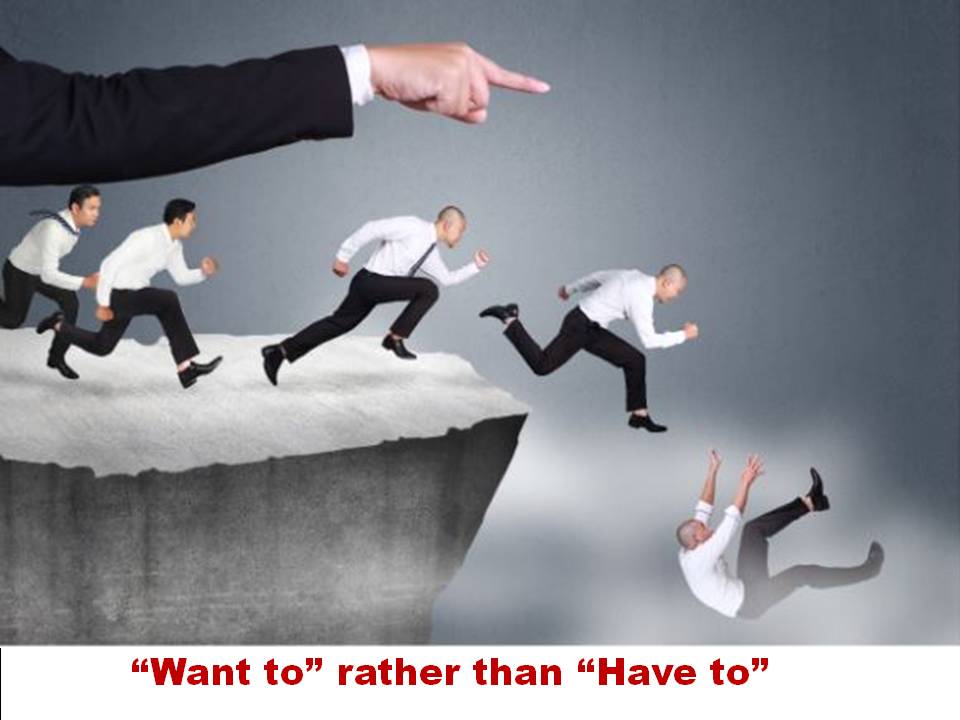by Peter A. Arthur-Smith, Leadership Solutions, Inc. ®
“…motivation grows at work when people satisfy their natural ‘seeking’ instinct to learn, experience, experiment and explore…It also comes when we express ourselves creatively, take on challenging tasks, and find purpose and meaning in our work.” Dan Cable, Professor of Organizational Behavior, London Business School – as offered in article by Sam Walker, Wall Street Journal Exchange section, entitled ‘Bosses (People) Recharging during COVID! – January 2021

Such profound words of people wisdom reinforce this author’s view that motivation in the workplace is about moving your people into “Want to” rather than “Have to.” Convent-ional management has for long enough been about creating the systems and processes to instill the latter, so that workplace people feel obliged to “work” the systems and “use” the processes – no real thinking is necessary. It’s in tune with the bookkeeping and production line mindset.
Management does all the upfront thinking and then all it needs are “pairs of hands” to take care of things. Even today these same managers fret over their people’s seeming inability to “think for themselves.” They also become anxious about their people’s level of motivation within conventional work environments. According to Gallup and many other sources that level currently stands at around 30-40%.Such profound words of people wisdom reinforce this author’s view that motivation in the workplace is about moving your people into “Want to” rather than “Have to.” Convent-ional management has for long enough been about creating the systems and processes to instill the latter, so that workplace people feel obliged to “work” the systems and “use” the processes – no real thinking is necessary. It’s in tune with the bookkeeping and production line mindset.
Compounding all of this, conventional managers are having to contend with our COVID crises and allowing the majority of non-production staff to work from home. As time wears on, you’re beginning to observe a growing chorus of “managers” arguing for their people to return to their office or workplace as soon as possible. While some of this is understandable, it’s clear that the complainers miss the opportunity to keep an eye on their people and satisfy their desire to look over their people’s shoulders. For many of them, it’s either a matter of habit or that they feel insecure without having people work under their noses. They just cannot come to terms with trusting people.
So let’s revisit Professor Cable’s suggestion of allowing people to learn, experience, experiment and explore; combined with having challenging tasks and finding purpose and meaning in one’s work. These sentiments seem to coincide quite nicely with the concept of enlightened leadership, which is largely about people and progress. Professor Cable’s people-desires can be pretty well fulfilled by doing the “thinking with them” instead of “doing it for them.”
Contrary to setting aside “management time” on your own to think through what needs to be done; you set aside “leadership time” to collaborate with affected team members to think through what needs to be done. This draws upon “wisdom of the crowd,” as well as naturally builds on your people’s commitment to pursue and accomplish any desired outcome. From there the conversation follows the path:
» Have you-they clarified your-their intentions and compelling purpose?
» Does your team feel it possesses the right know-how and expertise to be successful? How can they meet any shortfalls?
» Does your team feel it has at least the minimal level of resources – competent people, equipment,
systems, space, infrastructure, finance, etc. – to give them a decent shot at accomplishing their objectives? If not, how can they acquire them?
» Is there agreement on the appropriate path, with challenging milestones, in order to meet or surpass your-their intentions?
(NOTE: For people-leaders; these can all be accomplished within our current virtual environments, as well as within appropriately safe and distanced rooms.)
When there is consensus on these four points, then it’s likely your team’s level of motivation will be optimal and you are in a position to set it loose on whatever has been mapped-out; be that within an in-person or virtual setting. Your team will be set to record and share their progress at every milestone. New creativity will abound, adjustments will be made, and encouragement will be offered. Over time, many team members will be one step ahead of you and keep you informed and make appropriate suggestions.
Where team members fall short, you can review their efforts and talents with them such that they can discover where they need to enhance their capabilities or need new ones. You can either mentor them, where appropriate, assign their coaching to another team member, or involve a helpful “outsider.” Follow-through is essential until they begin building positive momentum, since the toughest part is always “getting started.”
By becoming accomplished with this more people-desirable approach, you will be viewed as an enlightened leader. Your people are much more likely to fully utilize their talents and they will also act in an optimally motivated manner – as well as feel fulfilled. Good luck!
To learn more about engage and people-involvement talk with:
